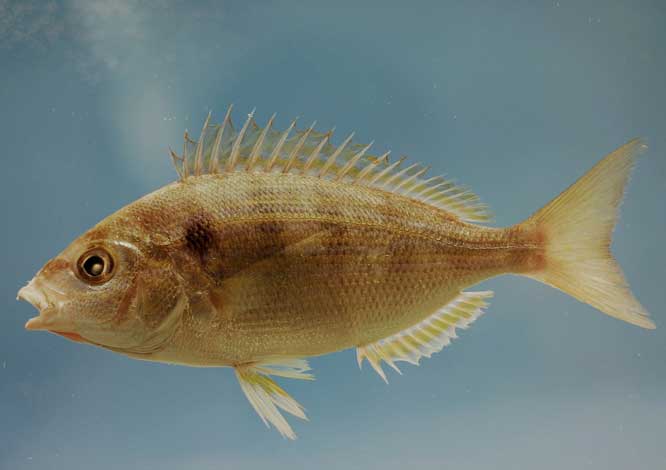Lagodon rhomboides (SEFSC Pascagoula Laboratory; Collection of Brandi Noble, NOAA/NMFS/SEFSC ) Cladus: Eukaryota Vernacular names -------- The pinfish, Lagodon rhomboides, is a saltwater fish of the Sparidae family (commonly called breams and porgies). It inhabits mostly subtropical shallow coastal waters of the Atlantic and Gulf coasts of the United States and Mexico. [1] The pinfish is a small fish, growing only to about 4.5 in (11.4 cm). Both males and females have a silvery sheen all over, five to six vertical bars on the side. They have an olive back, with yellow and white pigmentation and blue, green, and purple iridescence. [2] Its anterior dorsal fin has 12 rigid, spiny rays capable of superficially puncturing human skin (hence the common name pinfish) giving way posteriorally to 12 more short soft rays. Range The pinfish is found in Bermuda and along the United States coast from Massachusetts and a lot in Texas, and down along the Mexican Gulf Coast. It is also found along the northern Yucatan coast and some northern Caribbean islands, though it is less common throughout the tropical portions of its range. [1] Habitat Adult pinfish prefer protected waters of the Gulf between 30 and 50 feet deep, while juveniles are common over seagrass beds or other structure such as rocky bottoms, jetties, pilings, and in mangrove areas where there is cover from predators. They prefer water that has a higher salinity. Pinfish rarely school, but can be found near each other, especially along structure which supports barnacles and mollusks. [2] Diet Pinfish eat shrimp, fish eggs, insect larvae, polychaete worms and amphipods, and plant matter.[2] Predators Pinfish are preyed on by alligator gar, longnose gar, ladyfish, spotted seatrout, red drum, southern flounder, and bottlenose dolphin.[2] Reproduction Sexual maturity is reached at about one year, when the fish has reached 80 to 100 mm in length. Spawning season takes place in the fall and winter with eggs that are broadcast in the water by the female, then fertilized by the male. The number of eggs varies; approximately 7,000 to 90,000 that hatch after 48 hours. Young are not protected by adults. They are in the larval stage until they reach about 12 mm in length, then the juvenile stage until they reach 80 mm. Because they are eaten by many other species, the life span is generally short. [2] Importance as a Game and Foodfish Pinfish are not generally sought as sport or food in the United States due to their small size and numerous small bones. They are used as live bait by anglers targeting red drum, speckled sea trout and flounder. They may be caught on small hooks along piers and jetties, but often are considered a nuisance bait stealer. [2] References 1. ^ a b http://filaman.ifm-geomar.de/Summary/speciesSummary.php?ID=3576&genusname=Lagodon&speciesname=rhomboides
Source: Wikispecies, Wikipedia: All text is available under the terms of the GNU Free Documentation License |
|

